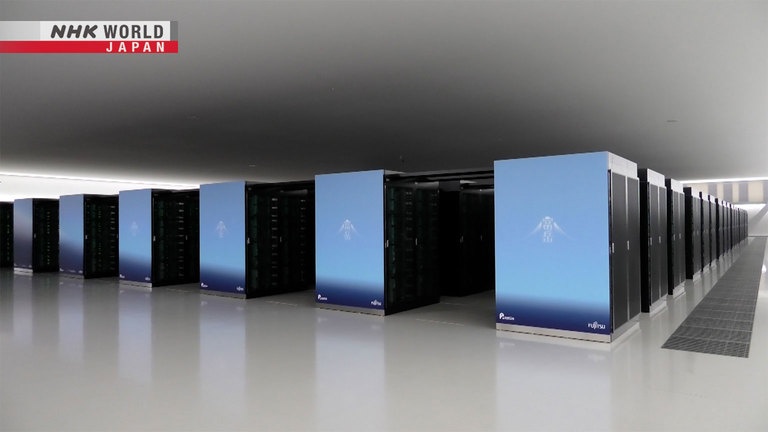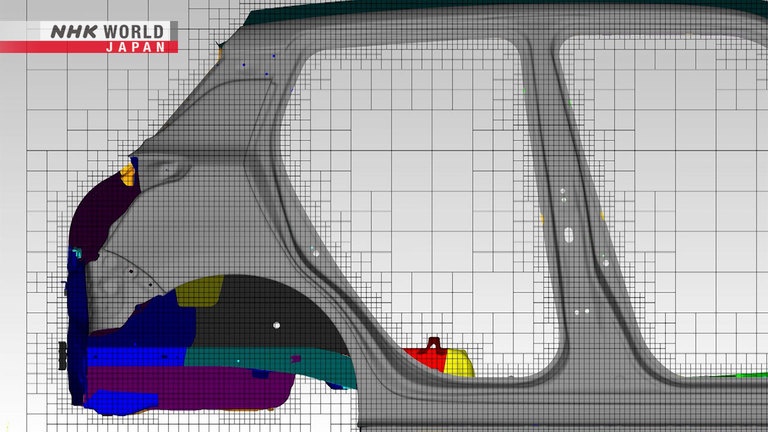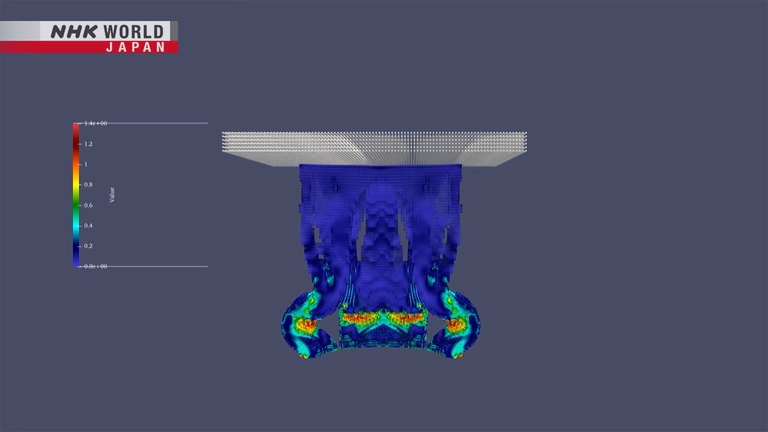The Dream of Generative AI Engineering - Koji Nishiguchi, Nagoya University
Research is ongoing to apply 3D generative AI to structural design. Koji Nishiguchi of Nagoya University is on the frontline, with a simulation method which used to be thought of as impractical.




Transcript
In November 2022, an American company published an AI chatbot, "ChatGPT."
Since then, many people have become familiar with generative artificial intelligence.
Generative AI creates not only text, but also images which are amazingly minute and realistic.
So much so that fake images sometimes confuse our society in a bad way.
And now, generative AI is broadening its field into 3D.
Koji Nishiguchi, Associate Professor at Nagoya University.
Nishiguchi is working on a 3D generative model incorporating structural mechanics.
A dream application.
We can easily use 3D generative AI with natural languages.
Non-experts in mechanics, such as artists and marketers,
can design structures.
That is my final goal.
If his idea is realized, our industrial scenes might undergo a revolution.
How is Nishiguchi approaching his structural design application with generative AI?
Today, we will focus on his study.
Koji Nishiguchi, Associate Professor at the Nagoya University, Graduate School of Engineering.
He is 38 years old, born in Hiroshima.
Three and half years ago, he came to Nagoya University and got his first laboratory in his life.
Computational mechanics is his area of study.
He researches the mechanics of various structures, analyzing them with computer simulations.
I think it should have generated a bit better results.
Yes, the outputs are too fat in shape, unfortunately.
Real shapes with a strain energy of 7.0 x 10^9
are a bit thinner.
Discussions with his grad and undergrad students are a source of many fresh ideas for him.
There is one thing that Nishiguchi has never given up in his academic life.
That is the "Eulerian finite volume method."
There are very few researchers who study this technique in the world.
For example, when we analyze the structural mechanics of automobile bodies,
we use a minute mesh for discretization, which means making many calculations for each cell.
The de facto standard is the "Lagrangian description."
A mesh is drawn along with the body shape.
On the other hand, Nishiguchi's "Eulerian description" uses an orthogonal mesh all over the space.
The Lagrangian method calculates only the necessary parts effectively.
However, because the mesh is drawn exquisitely along the body,
we have to draw a new mesh if the design is changed.
On the other hand, the Eulerian method requires a huge amount of calculations
because it also draws a mesh on the empty space.
However, the mesh is simply orthogonal lines and is easy to redraw for different shapes.
Until recent years, Lagrangian has been used in most cases, due to the limits of computers.
And most people thought Eulerian was not applicable to complicated structures such as automobiles,
and so there were very few experts.
My seniors and colleagues often said,
"Nishiguchi, you should not stick to Eulerian,
but change your theme of research."
And even in international conferences,
when I made a presentation on the Eulerian method,
I got many negative reactions,
"This is difficult to use on complicated structures,
like metal materials or automobiles."
I did not agree, perhaps a bit defiant...
I believe in the potential of the Eulerian method.
So, I haven't given up, and continue to pursue it.
Nishiguchi met the Eulerian method in 2007,
when he was a senior student at Hiroshima University and joined the Laboratory of Structural Systems.
These are his Eulerian simulations in 2010.
Only such simpler and limited simulations were possible with the computers in those days.
However, Nishiguchi believed he would be able to conduct more complicated
and realistic simulations of automobile structures and their collisions in the future,
when computers got more powerful.
I was a kid who pursued only one thing.
Maybe that's why I stick to Eulerian.
Also, the number of Eulerian researchers was very few.
I know of only a few groups around the world.
So, I once thought,
"Eulerian structural analysis could disappear
if I give it up."
When he searched for a job after earning his masters degree,
he chose a materials manufacturing company where he could continue his study of the Eulerian method.
However, he felt a certain limit in his research within the company.
He kept studying there and got a PhD degree,
but he wanted a place where he could concentrate on his research.
One day, he got a great chance.
In 2016, he met Professor Makoto Tsubokura,
a team leader at the Riken Center for Computational Science.
He scouted Nishiguchi, a new PhD working at a materials manufacturer, to work at Riken.
When I first met him, he was still at the company.
I knew the theme of his PhD dissertation.
I really wanted him to join my team.
Soon after Nishiguchi joined Riken, the institute started operating the fastest supercomputer at that time.
Fugaku.
And, Nishiguchi was astounded with its amazing computational capacity.
In 2020, the pandemic spread all over the world.
The cases and deaths of COVID-19 continued increasing.
People were overwhelmed with a huge fear.
Is COVID transmitted through the air? Is wearing masks effective?
About the unknown virus, there was a huge amount of unreliable, sometimes rootless, rumors in our society.
Team Tsubokura, including Nishiguchi, decided to make full use of Fugaku to answer these questions.
That is, "Viral Droplet and Aerosol Dispersion Simulation."
They wanted to provide the public with correct information based on scientific data.
After only a month from launch, their simulations clearly showed
that masks and desktop partitions are quite effective to prevent droplet dispersion.
And at the end of August, just before school resumed,
it showed how to open doors and windows for the most effective ventilation.
Over two years, team Tsubokura ran about 1,500 simulations,
and continued publishing critical information for our society.
These Riken simulations by supercomputer Fugaku were highly evaluated among the world.
In the Viral Droplet and Aerosol Dispersion Simulation,
the Eulerian method played a big part.
The Eulerian method is faster than the Lagrangian.
The Eulerian contributed a lot to make simulations quicker.
The advantage of the Eulerian method was fully realized by the amazing calculation power of Supercomputer Fugaku,
and Riken was able to publish many exhausting simulations in a very short term, almost every month.
Nishiguchi had confirmed the potential of the Eulerian method.
It happened in very recent years,
due to the progress of supercomputers.
Our team has developed a way
to make the most of Fugaku.
Also, we have been conducting fundamental studies
of the Eulerian method.
All these things combined made simulations
more realistic, in a manner.
It was quite an unexpected collaboration that has further convinced Nishiguchi of the potential of the Eulerian method.
In aging societies like Japan,
there are many cases where elder people fall and break their bones.
And not a small number of such people are forced to be confined to bed for the rest of their lives.
Is there any way to prevent such accidents?
A venture company in Hamamatsu has developed a magical sheet,
which is firm in normal use but gets soft when a strong impact falls on it.
A wheel chair can smoothly move on the sheet, without sinking at all.
However, when someone falls down on it, it collapses and absorbs the shock.
The sheet is made of an elastic resin, and its secret lies in its structure.
It has space so that it can absorb shocks at strong impacts.
And it is supported with many pillars so that it stays firm with daily activity.
Hiroshi Shimomura invented this sheet.
His grandmother fell down and broke her thigh bone,
and stayed in the bed until she passed away.
Then Shimomura started developing devices to prevent such tragic injuries, and founded his company in 2019.
He has reached the current product after he made a number of prototypes
and fell on it by himself countless times.
But he realized that he needed scientific proof of its function.
Shimomura asked many dynamics researchers for simulations,
but all of them said it was impossible, except for Nishiguchi.
Prof. Nishiguchi said,
"It is not possible with conventional ways."
But he knew of a method that makes it possible.
So we started a collaboration for simulations.
Of course, Nishiguchi used the Eulerian method for his computer simulations.
The Eulerian method draws a mesh not on the surface but in the space.
It can calculate both deformed structures and air at the same time.
It made it possible to simulate this magical sheet with a complicated shape.
When a Japanese male falls down, his thigh bone receives an impact of about 3,200 Newtons.
This sheet reduces the shock by half, to 1,600 Newtons.
And Nishiguchi's Eulerian simulation showed the mechanism quite vividly.
Prof. Nishiguchi's simulations presented the effects of
deformation and air in actual situations.
I was very surprised.
The Eulerian method can calculate
both structures and fluids
and can deal with large deformations.
And now, we can use supercomputers.
The simulation results are very consistent with reality.
The Eulerian method is not a new one.
It was used in the 1950s by the U.S. military, in order to analyze the detonation of bombs.
A large part of this usage was classified until the 1990s.
And so, the papers and articles available to civilian researchers were quite limited.
This history would be one of the reasons why the researchers of the Eulerian method are not so many.
Computers are getting more and more powerful at an amazing pace.
ASCI White in the United States, the best supercomputer in the world in 2001,
is said to have had capacity equivalent to the iPhone in 2020.
Looking at the computational capacities of the fastest supercomputers,
they started growing rapidly in around 2019.
That capacity has become eight times in four years.
What is called "parallel computing" makes this improvement possible.
State-of-the-art supercomputers have hundreds of thousands of CPUs and millions of GPUs,
and carry out tremendous numbers of calculations at the same time.
And this parallel computing fits very well with the Eulerian method.
With current supercomputers, the amount of calculations with the Eulerian method is not an issue any more.
As global warming is becoming a serious issue,
the automobile manufacturers of the world are shifting to electric vehicles.
A motor show in Guangzhou, China, in November 2023.
About 40% of the displayed cars were new energy vehicles, such as electric vehicles and plug-in hybrids.
Japanese motor companies are also speeding up their new-car developments.
In this situation, they are attracted to the Eulerian method, which could make structural calculations faster.
Nishiguchi is conducting a joint study with Toyota Motor Corporation on structural design with the Eulerian method.
I think Nishiguchi's Eulerian method
has great potential.
We need to make larger calculations with faster speed.
I hope this collaboration bears a good result.
Now 3D printing and giga-casting have emerged,
and geometrical freedom in car development
is getting greater.
Of course, this improves the quality of cars,
but the designs are getting
more complicated and difficult.
If we could design various structures more easily,
it could help us find totally new things.
For example, structures with lighter weights
which absorb shocks more effectively.
As the capacity of supercomputers rapidly grows, artificial intelligence is undergoing evolution at a tremendous pace.
The scale of large language models is explosively getting gigantic.
Number of parameters used to be 50 million in 2017,
but it grew 30 thousand times in four years into 1.6 trillion in 2021.
AI's ability to understand our language and generate text and images
responding to our requests keeps growing rapidly.
This is supercomputer "Fugaku."
This system has about 160 thousand CPUs.
With this supercomputer and the Eulerian method, isn't it possible to build a 3D generative model,
incorporating mechanical information like shock-absorbing capabilities?
As the first step, Nishiguchi chose the "crash box," which is located at the front of the automobile frame.
Crash boxes are installed right behind the bumper.
In the case of a collision, they are crushed in order to absorb the shock.
Generative AI needs to learn a huge amount of data.
In the case of text and images, there are a limitless number of materials.
However, there are few data on crash boxes.
So Nishiguchi simulated many crash boxes in a virtual space.
Such simulations are possible only with the Eulerian method, which uses simple orthogonal meshes.
Nishiguchi prepared a data set with about 1,000 samples, and let the AI learn them.
What kind of things will the AI generate?
The results were - the output shapes were very good,
but the mechanical parameters were far from being accurate.
But Nishiguchi kept making the data set larger.
Other areas of generative AI - text, images, music,
its ability improves as the data set gets larger.
So, I think the same thing will happen
with 3D generative AI.
In January, 2024, an international conference on high performance computing was held in Nagoya.
I would like to construct a 3D generative model incorporating structural dynamics.
Nishiguchi reported on the newest results of his research on 3D generative AI.
As you can see from this distribution,
the error is almost the same between the trained data and unseen data.
So this is an example of an unseen shape.
And this one is the generated shape.
As you can see, we successfully generate a 3D shape by using our trained 3D AI.
This time, he did the same trial with 6,000 crash box samples, six times more than before.
The mechanical parameters of the output had surprisingly improved, up to 90% accuracy.
The results seem to reach a level where we could expect to use them for actual designs.
We were also surprised at the performance of the AI.
From now on, we will keep building up the data set
to 10,000 and 100,000.
Then I expect the results will get better and better.
In the fields of text and images, what is called "emergent abilities" are reported.
When the amount of learning surpasses a certain level, generative AI's abilities suddenly improve.
Nishiguchi expects the same thing with his 3D generative AI.
Human beings can accept linear improvements,
but exponential changes are counterintuitive.
That would be the reason why most of us feel
this tremendous AI emerged out of the blue.
Nishiguchi is now on the front line of AI research.
He thinks that is because he didn't give up the Eulerian method that he met in college,
and kept chasing after his dream.
As you know, "Moore's Law" says
the capacity of computers doubles every two years.
This is an exponential change,
at a counterintuitive speed.
I think we need to backcast from the future
10 years, 20 years from now.
We need to imagine
what seems impossible even as of today.
His journey to 3D generative AI has just begun.
There used to be very few researchers in this field, but it has started attracting attention.
Now, Nishiguchi is actively conducting joint research.
He believes that the goal of engineering
is to provide people with solutions to their troubles and complaints.
To be one of the researchers tackling a big issue in our society.
That is Nishiguchi's wish.